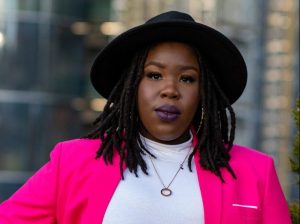Shaking Up the Status Quo in the Design Industry
IIDA New York's Shawnasia Black is committed to bringing difficult conversations to the forefront, and promoting equity in the design community.
Real estate-adjacent industries such as architecture and design are making advancements to become more equitable and inclusive, but the work is far from over. One of the entities fighting to foster engagement and accountability toward meaningful change in the architecture and design industry is the Equity Council within the International Interior Design Association (IIDA).
Shawnasia Black—interior designer at Beyer Blinder Belle, and co-chair at IIDA’s Equity Council—is relentlessly advocating for more diversity in the design community and constantly challenging the industry’s status quo. In the interview below, Black talks about how interior designers can leverage their skills to further advance DEI objectives within their companies and the architecture and design industry as a whole.
Why did you choose to work in interior design? What drives you to excel?
Black: After graduating from Clark University in Worcester, Mass., with a bachelor’s degree in Psychology and a Master’s in Professional Communications, I began working a series of odd jobs along with a volunteer opportunity that led me to a nonprofit called Publicolor. This organization engages underserved youth through the power of paint. I was eventually hired by Publicolor and worked with students, who were involved in beautifying schools and community centers in their neighborhoods while receiving mentorship, vocational, and scholarship opportunities.
I then started receiving requests from friends and family to paint their spaces and was enlisted by my best friend to paint a geometric design in her bedroom of her mom’s new house. During the process, her mom noticed my work and attention to detail and said, ‘Wow, you should really go to school for this.’ It was that acknowledgement that planted a seed to explore the possibility of a design career. I then researched interior design programs in New York City which led me to Fashion Institute of Technology where I eventually graduated with a B.A. in Interior Design.
As a designer, I’m driven by the effects of the built environment on the end user. While working at Publicolor, I witnessed first-hand the effects of changing one’s environment. I noticed a shift in how people interacted with the spaces and even each other. This is something that has stayed with me throughout my tenure in the design industry.
READ ALSO: The Role of Education in Advancing DEI
Could you please expand on your role within the Equity Council? I saw there is a DEI pledge that companies can take. In what way does this pledge help?
Black: Our mission is to create a more just and equitable design industry by focusing on four key pillars in the workplace: cultures of inclusion, increased racial diversity, education and communication.
Equity Council seeks to bridge the inequities gap with the Design Industry Pledge, an agreement that outlines actionable goals. It includes an assessment tool for signers to measure their progress annually. The Design Industry Pledge is open to the entire design community and industry partners alike—members and non-members of IIDA NY—including professional associations, project managers, consultants, contractors and others. We provide educational tools and resources to use as a starting point for firms and organizations to engage in justice, equity, diversity and inclusion (JEDI) practices within their workplace. Ultimately, Equity Council is striving to become the DEI resource for the design industry.
Equity Council has been a pillar of support for me, and through my position as co-chair, I find myself constantly evolving within our programming. I collaborate with fellow Co-Chair & Co-Founder of Equity Council, Elsie St. Léger, on various educational and community initiatives. We are committed to education, advocacy and challenging the status quo in the design industry.
What are some initiatives the Equity Council is currently working on, and how are they being implemented?
Black: Inequities for people of color in America are deeply rooted in historical systems of injustice that manifest in all manner of ways, including the built environment. Some of our greatest initiatives have been partnering with consultants like Racial Equity Partner and Co-Creating Inclusion.
With REP, we’ve been able to provide a safe space for designers and design professionals to have difficult conversations about racial inequity, such as microaggressions, colorism etc. We offer these discussions monthly, and we’ve learned from our attendees that no other entity in the architecture and design industry is offering a platform for these much-needed conversations.
Currently, in collaboration with CCI, we are rolling our four-part series titled JEDI Action Lab. These JEDI action labs, held throughout February and March, are an interactive forum that allows attendees to develop or enhance one area of the JEDI & Belonging efforts on behalf of their firm/organization/company.
Do you think the design industry is on the right track to address its issues of equity, diversity and inclusion? Why/why not?
Black: Sadly, the interior design industry continues to lag in racial equity, especially in various roles that make up the industry that often get overlooked. We’re not all architects and interior designers, there are also product designers, furniture designers, manufacturers, sales reps etc. that make up this illustrious industry.
All these design professionals are needed to engage in conversations of diversity and inclusion and therefore should all be invited to the table. The beauty of this industry largely stems from the diverse teams that bring built spaces to life, and we need a collective effort to pave the way for the next generation of designers and architects.
Adding to that, I think more support is needed in education. One of the reasons I was drawn to my current firm is their direct connection to some historically Black colleges and universities. That connection is important, and I would challenge everyone in this industry to reach even younger audiences, to plant the seeds of architecture and design earlier. In both design-based and traditional high school settings, more support is needed to promote this industry and make young minds aware of their career possibilities. I also encourage more BIPOC design professionals in the industry to lend themselves to mentorship opportunities. I feel it will lead to more media representation, feeding back into more diverse design education and ultimately increasing representation in the education of design overall.
What were some recent successes you’ve had in this ordeal, an achievement you feel proud to have worked on?
Black: Professionally, I am most proud of the work I was able to do for The Brotherhood Sister Sol (BroSis) with building their new headquarters in Hamilton Heights, N.Y. BroSis is a not-for-profit organization that was founded in 1995 to provide comprehensive, holistic and long-term support to children between the ages of 8 and 22… With the time spent on this project, the young people that are a part of the BroSis family were able to see a team of Black architects and designers building their new home. A daily thought I had was who will I inspire today. Who knows what young designers might see me onsite, and maybe that could be their inkling to get into the design industry?
I am also proud of the work I am doing as Equity Council co-chair by providing a safe space within the design industry to have difficult conversations. For example, last year, Equity Council in partnership with REP hosted a virtual panel discussion titled ‘Hair Love & Law.’ It was one of our more impactful conversations to date, centered around the biases created in the American workplace based on natural physical traits—hair, skin color, body type etc.—toward people of color. We were able to start an important conversation in a safe, supportive and inclusive environment among some designers who are learning greater empathy for all those involved in the industry.
LISTEN TO: CREW Up Podcast—Working Together Toward Pay Equity in CRE
In another interview, you mentioned you would like to educate the younger generations about the role interior design can play in furthering the objective of equity. Has this desire materialized?
Black: Absolutely! Equity Council has put me in this spotlight that I was not sure I was ready for, but I am grateful because it permits me to speak to the audiences that I want to reach. Most recently, I was invited to sit on a panel with Jennifer Graham, principal of corporate interiors at Perkins & Will, and Catherine Murphy, senior researcher at Healthy Materials Lab, to discuss how interior designers can leverage their skills as agents of change to challenge structural inequalities in the built environment. The event was a collaboration between NYSID, ASID & Well-Designed, co-founded by Caleb Anderson and DeAndre DeVane.
To my own detriment, I never say ‘no’ when it comes to opportunities to speak with younger generations. I’m also a current member of the FIT Advisory Board and have been able to sit in on some senior design presentations and give feedback to up-and-coming designers. I remember how unprepared for the real world I was graduating with a design degree at the age of 26, so I could barely imagine how 21- and 22-year-olds were feeling. It was an amazing opportunity to talk to design students who are gearing up to graduate and enter the workforce.
What are some of your goals for this year?
Black: One of our main goals is to obtain more pledge signers and encourage more action behind signing our pledge. We want to encourage firms to sign the pledge dedicating themselves to an increase in an inclusive culture, diversity, education and healthy communication.
Adding to that, a personal goal of mine is to increase memberships and representation in the Equity Council… Through my position as co-chair, I find myself constantly evolving within our programming. However, I know that we can grow our organization beyond its current membership. In fact, we need this growth to have holistic conversations around JEDI.
Do you have a message for other people who are relentlessly working to advance the DEI cause in the architecture and design industry? Why does their work matter?
Black: Any work involved in advancing DEI is time consuming. For those looking to become more involved, please be kind to yourself and understand that everyone is learning as they move forward. Also understand that you cannot perform this mission alone so it’s so important to surround yourself with supportive team members who work together as a collective effort. And of course, rest is also an important consideration during these unprecedented times. The work you put into this effort will eventually pay off. In the beginning, you may encounter several roadblocks but over time, you will see dividends in the work created to make change.








You must be logged in to post a comment.